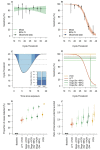Using trained dogs and organic semi-conducting sensors to identify asymptomatic and mild SARS-CoV-2 infections: an observational study
- PMID: 35325195
- PMCID: PMC9047163
- DOI: 10.1093/jtm/taac043
Using trained dogs and organic semi-conducting sensors to identify asymptomatic and mild SARS-CoV-2 infections: an observational study
Abstract
Background: A rapid, accurate, non-invasive diagnostic screen is needed to identify people with SARS-CoV-2 infection. We investigated whether organic semi-conducting (OSC) sensors and trained dogs could distinguish between people infected with asymptomatic or mild symptoms, and uninfected individuals, and the impact of screening at ports-of-entry.
Methods: Odour samples were collected from adults, and SARS-CoV-2 infection status confirmed using RT-PCR. OSC sensors captured the volatile organic compound (VOC) profile of odour samples. Trained dogs were tested in a double-blind trial to determine their ability to detect differences in VOCs between infected and uninfected individuals, with sensitivity and specificity as the primary outcome. Mathematical modelling was used to investigate the impact of bio-detection dogs for screening.
Results: About, 3921 adults were enrolled in the study and odour samples collected from 1097 SARS-CoV-2 infected and 2031 uninfected individuals. OSC sensors were able to distinguish between SARS-CoV-2 infected individuals and uninfected, with sensitivity from 98% (95% CI 95-100) to 100% and specificity from 99% (95% CI 97-100) to 100%. Six dogs were able to distinguish between samples with sensitivity ranging from 82% (95% CI 76-87) to 94% (95% CI 89-98) and specificity ranging from 76% (95% CI 70-82) to 92% (95% CI 88-96). Mathematical modelling suggests that dog screening plus a confirmatory PCR test could detect up to 89% of SARS-CoV-2 infections, averting up to 2.2 times as much transmission compared to isolation of symptomatic individuals only.
Conclusions: People infected with SARS-CoV-2, with asymptomatic or mild symptoms, have a distinct odour that can be identified by sensors and trained dogs with a high degree of accuracy. Odour-based diagnostics using sensors and/or dogs may prove a rapid and effective tool for screening large numbers of people.Trial Registration NCT04509713 (clinicaltrials.gov).
Keywords: COVID-19; infection control; public health; rapid screening.
© The Author(s) 2022. Published by Oxford University Press on behalf of International Society of Travel Medicine.
Figures



References
-
- Mahase E. Covid-19: what new variants are emerging and how are they being investigated? BMJ 2021; 372:n158. - PubMed
Publication types
MeSH terms
Substances
Associated data
Grants and funding
LinkOut - more resources
Full Text Sources
Medical
Miscellaneous

